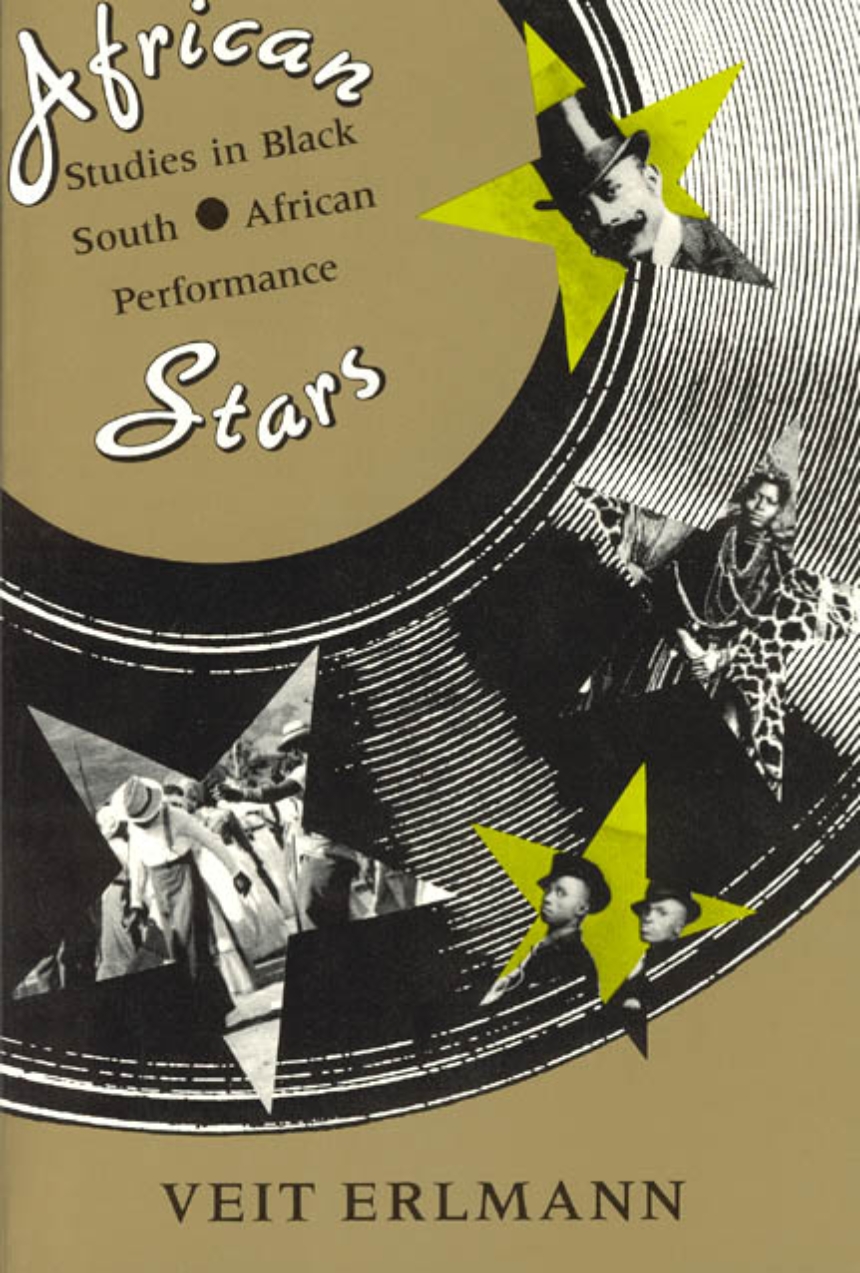African Stars
Studies in Black South African Performance
In recent years black South African music and dance have
become ever more popular in the West, where they are now
widely celebrated as expressions of opposition to
discrimination and repression. Less well known is the
rich history of these arts, which were shaped by several
generations of black artists and performers whose
struggles, visions, and aspirations did not differ fundamentally
from those of their present-day counterparts.
In five detailed case studies Veit Erlmann digs deep to expose the roots of the most important of these performance traditions. He relates the early history of isicathamiya, the a cappella vocal style made famous by Ladysmith Black Mambazo.
In two chapters on Durban between the World Wars he charts the evolution of Zulu music and dance, studying in depth the transformation of ingoma, a dance form popular among migrant workers since the 1930s. He goes on to
record the colorful life and influential work of Reuben T. Caluza,
South Africa’s first black ragtime composer. And Erlmann’s reconstruction of the 1890s concert tours of an Afro-American vocal group, Orpheus M. McAdoo and the Virginia Jubilee Singers, documents the earliest link between the African and American performance traditions.
Numerous eyewitness reports, musicians’ personal testimonies, and song texts enrich Erlmann’s narratives and demonstrate that black performance evolved in response to the growing economic and racial segmentation of South African
society. Early ragtime, ingoma, and isicathamiya enabled the black urban population to comment on their precarious social position and to symbolically construct a secure space within a rapidly changing political world.
Today, South African workers, artists, and youth continue to build upon this performance tradition in their struggle for freedom and democracy. The early performers portrayed by Erlmann were guiding lights—African stars—by which the present and future course of South Africa is being determined.
become ever more popular in the West, where they are now
widely celebrated as expressions of opposition to
discrimination and repression. Less well known is the
rich history of these arts, which were shaped by several
generations of black artists and performers whose
struggles, visions, and aspirations did not differ fundamentally
from those of their present-day counterparts.
In five detailed case studies Veit Erlmann digs deep to expose the roots of the most important of these performance traditions. He relates the early history of isicathamiya, the a cappella vocal style made famous by Ladysmith Black Mambazo.
In two chapters on Durban between the World Wars he charts the evolution of Zulu music and dance, studying in depth the transformation of ingoma, a dance form popular among migrant workers since the 1930s. He goes on to
record the colorful life and influential work of Reuben T. Caluza,
South Africa’s first black ragtime composer. And Erlmann’s reconstruction of the 1890s concert tours of an Afro-American vocal group, Orpheus M. McAdoo and the Virginia Jubilee Singers, documents the earliest link between the African and American performance traditions.
Numerous eyewitness reports, musicians’ personal testimonies, and song texts enrich Erlmann’s narratives and demonstrate that black performance evolved in response to the growing economic and racial segmentation of South African
society. Early ragtime, ingoma, and isicathamiya enabled the black urban population to comment on their precarious social position and to symbolically construct a secure space within a rapidly changing political world.
Today, South African workers, artists, and youth continue to build upon this performance tradition in their struggle for freedom and democracy. The early performers portrayed by Erlmann were guiding lights—African stars—by which the present and future course of South Africa is being determined.
238 pages | 20 halftones, 4 musical examples | 6 x 9 | © 1991
Chicago Studies in Ethnomusicology
Music: Ethnomusicology
Table of Contents
List of Illustrations
List of Musical Examples
A Note on Orthography and Translations
Preface
1. Introduction
2. "A Feeling of Prejudice": Orpheus M. McAdoo and the Virginia Jubilee Singers in South Africa, 1890-1898
3. Cultural Osmosis, Ethnicity, and Tradition in Black Popular Music in Durban, 1913-1939
4. "Horses in the Race Course": The Domestication of Ingoma Dance, 1929-1939
5. "An African Star": Reuben T. Caluza and Early Popular Music in South Africa
6. "Singing Brings Joy to the Distressed": The Early Social History of Zulu Migrant Workers’ Choral Music
7. Conclusion: South African Black Music and the Wider African Field
Notes
References
Index
List of Musical Examples
A Note on Orthography and Translations
Preface
1. Introduction
2. "A Feeling of Prejudice": Orpheus M. McAdoo and the Virginia Jubilee Singers in South Africa, 1890-1898
3. Cultural Osmosis, Ethnicity, and Tradition in Black Popular Music in Durban, 1913-1939
4. "Horses in the Race Course": The Domestication of Ingoma Dance, 1929-1939
5. "An African Star": Reuben T. Caluza and Early Popular Music in South Africa
6. "Singing Brings Joy to the Distressed": The Early Social History of Zulu Migrant Workers’ Choral Music
7. Conclusion: South African Black Music and the Wider African Field
Notes
References
Index
